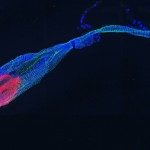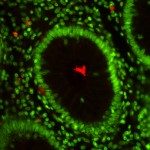Lien vers Pubmed [PMID] – 16251186
J. Biol. Chem. 2006 Jan;281(4):2317-32
Protein conjugates of oligosaccharides or peptides that mimic complex bacterial polysaccharide antigens represent alternatives to the classical polysaccharide-based conjugate vaccines developed so far. Hence, a better understanding of the molecular basis ensuring appropriate mimicry is required in order to design efficient carbohydrate mimic-based vaccines. This study focuses on the following two unrelated sets of mimics of the Shigella flexneri 5a O-specific polysaccharide (O-SP): (i) a synthetic branched pentasaccharide known to mimic the average solution conformation of S. flexneri 5a O-SP, and (ii) three nonapeptides selected upon screening of phage-displayed peptide libraries with two protective murine monoclonal antibodies (mAbs) of the A isotype specific for S. flexneri 5a O-SP. By inducing anti-O-SP antibodies upon immunization in mice when appropriately presented to the immune system, the pentasaccharide and peptides p100c and p115, but not peptide p22, were qualified as mimotopes of the native antigen. NMR studies based on transferred NOE (trNOE) experiments revealed that both kinds of mimotopes had an average conformation when bound to the mAbs that was close to that of their free form. Most interestingly, saturation transfer difference (STD) experiments showed that the characteristic turn conformations adopted by the major conformers of p100c and p115, as well as of p22, are clearly involved in mAb binding. These latter experiments also showed that the branched glucose residue of the pentasaccharide was a key part of the determinant recognized by the protective mAbs. Finally, by using NMR-derived pentasaccharide and peptide conformations coupled to STD information, models of antigen-antibody interaction were obtained. Most interestingly, only one model was found compatible with experimental data when large O-SP fragments were docked into one of the mIgA-binding sites. This newly made available system provides a new contribution to the understanding of the molecular mimicry of complex polysaccharides by peptides and short oligosaccharides.


